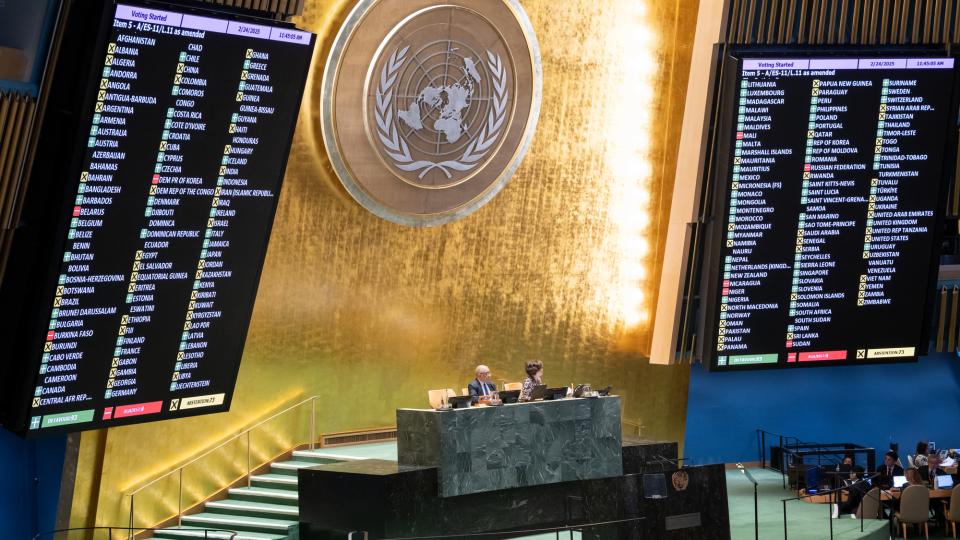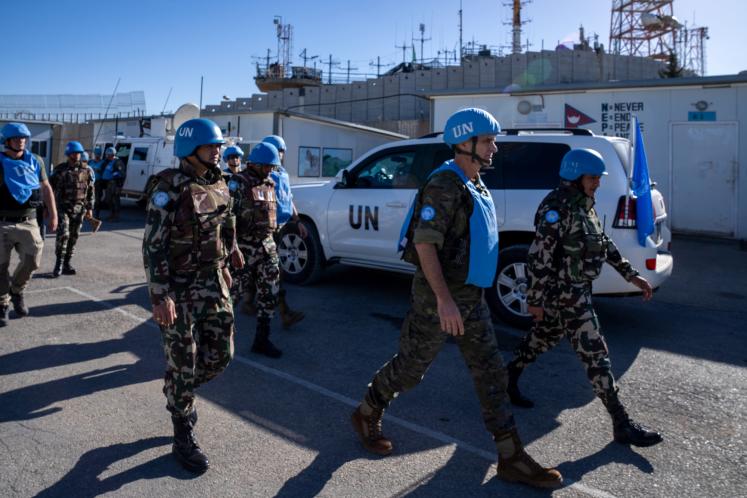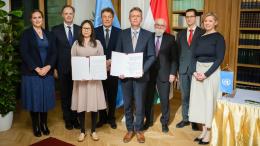From the ongoing conflict and humanitarian aid crisis in Ukraine and Gaza, to conflicts emerging in the eastern Democratic Republic of Congo and on the India-Pakistan border earlier this year, as well as fast-escalating hostilities in the Middle East, there appears to be no shortage of situations crying out for crisis management.
Yet increasing divisions and vetoes by permanent members of the Security Council – including on many of the above situations – have limited the sort of collective responses that might help to de-escalate, manage and resolve such situations. As a result, attention has swung to alternative forums for authorizing collective action, in particular the General Assembly.
Responding to attacks on aid convoys and food distribution in places as diverse as Gaza, Sudan, the Central African Republic and Haiti, the UN Special Rapporteur on the right to food, Michael Fakhri, last week proposed that the UN General Assembly authorize peacekeeping forces to accompany and protect humanitarian aid convoys. Scholars responding to the League of Arab States’ call to establish a UN force in occupied Palestinian territories have mooted that if the Security Council would not authorize such a force (given the US veto), the General Assembly might do so.
While the prospects of a ceasefire in Ukraine do not appear immediate, should one be reached, a range of Security Council vetoes might bar it from supporting the ceasefire monitoring body necessary to see it through, generating the need for another UN body with the legal authority to authorize such missions. All of this leads to a central question: Can the General Assembly authorize a peacekeeping force or other type of peace operation? Under what conditions has it done so in the past? And, are there any limitations on its ability to act – legal, political or otherwise?
In 2024, UNU-CPR, in partnership with the President of the General Assembly and other Member States, produced a Digital Handbook for the General Assembly that responds to just these questions, as well as identifying other General Assembly powers and past practice related to peace and security issues. In May 2025, UNU-CPR organized a workshop for Member States focused on the learning in the Handbook related to General Assembly engagement with peace operations. Here are 7 of the main questions and take-aways from that session, also expanded upon in greater detail in a new Summary Brief on the General Assembly’s past practice and engagement on peace operations.
1. Can the General Assembly authorize peace operations, including armed peacekeepers?
Yes, the General Assembly has mandated or authorized peace operations throughout its history, including the first armed UN peacekeeping force in 1956, the UN Emergency Force (UNEF), in response to the Suez Crisis; the first UN peace operation to administer a territory, the UN Temporary Executive Authority (UNTEA) in 1962; and the first joint UN peace operation with a regional body, in Haiti in 1993. A General Assembly-authorized peace operation also oversaw peace talks and a transition out of civil war in the 1990s in Guatemala. More recently, the General Assembly supported a regional monitoring mission and a special envoy in Syria in 2011 and 2012, as well as other actions leading to two of the main peace operations and related operational bodies operating in the Middle East to the present.
2. What do General Assembly-authorized peace operations do? Are they any different than those authorized by the Security Council?
The General Assembly has authorized a full suite of peace operations, with the same range of functions as those mandated by the Security Council. Some General Assembly-mandated peace operations have acted more like today’s multi-dimensional peacekeeping operations, with armed peacekeepers helping to monitor ceasefires; oversee withdrawal of forces, disarmament and demobilization; and/or supporting on rule of law and policing. Others have been more like today’s "special political missions" and were entirely civilian missions, focused on supporting mediation and regional good offices (i.e. in the Balkans, and surrounding Afghanistan), or monitoring human rights, elections or other transition processes. Some General Assembly-supported operations have worked inter-operatively with the deployment of peacekeepers by the Security Council (for example, in Guatemala and Haiti).
General Assembly-authorized peace operations have also frequently helped coordinate humanitarian aid and refugee support. An example is the United Nations Relief and Works Agency for Palestine Refugees in the Near East (UNRWA), which the General Assembly established in 1949. While not formally a peace operation, it is a complex, operational body that has played an important operational role in conflict management analogous to that played by many peace operations.
3. What is the legal basis for the General Assembly to authorize a peace operation?
Articles 10, 11 and 14 of the UN Charter give the General Assembly power to deliberate over and pass any recommendations it deems appropriate to the “maintenance of international peace and security”, and the peaceful resolution of disputes, including the range of conflicts and crises where a peace operation might be appropriate. An International Court of Justice (ICJ) advisory opinion in 1961 clarified that this is not just the power to debate remedies, but that General Assembly recommendations can support operational or follow-on action, for example, by creating bodies, commissions, or other crisis management or conflict resolution mechanisms (Article 22 of the UN Charter gives the General Assembly the power to create such bodies). That ICJ opinion specifically considered General Assembly resolutions that mandated and extended peace operations in Egypt and the Congo, respectively.

One important legal limit is that because the General Assembly does not have mandatory, coercive power (only the Security Council does), peace operations or other bodies mandated by the General Assembly can only deploy to the territory with the consent of the country involved. However, in modern peace operations practice, consent by the host country is generally considered a best practice, if not a prerequisite, as it is for Security Council-mandated peace operations.
4. If the General Assembly has the power to mandate peace operations, why hasn’t it done so more often, or more recently?
Although the General Assembly has the power to authorize peace operations, the UN Charter was designed to give the Security Council primary responsibility over peace and security matters. The General Assembly has generally deferred to that and engaged with peace operations a) when the Security Council is unable to act due to divisions among permanent members; b) at the request of the parties; or c) when the nature of the peace operation is more aligned with the General Assembly’s mandate or past engagement. Where the General Assembly has stepped in when the Security Council has been unable to act, it has generally been welcomed by Security Council members and by the parties involved as a crucial stopgap or bridging function to support necessary conflict management functions. In essence, the General Assembly plays a complementary role to the Security Council on peace operations, acting as a safety valve when the Security Council is deadlocked. As a result, it has not had to be as active in the last two decades, but that may be changing given shifting international dynamics.
5. Can the General Assembly do anything to support existing (Security Council-authorized) peace operations where the Council is divided?
Although this has not been common, the General Assembly has modified the tasks, mandate or duration of existing (Security Council-authorized) peace operations. Two cases discussed in the Handbook (in 1958 with a border monitoring force in Lebanon, and in 1961 in the Congo) help illustrate how the General Assembly might do this. In both cases, the General Assembly stepped in after Security Council divisions prevented it from making modifications to the mandate that would be necessary for the missions to deal with a changed or more complex situation. In both cases, after the General Assembly supported additional tasks or a more robust mandate within these two missions, the Security Council later re-engaged with these matters, tacitly accepting and ratifying the General Assembly-mandated changes.
These past precedents may be particularly relevant at the present moment, given that in some of the most urgent crisis situations, there is already a UN peace operation, but modifying its mandate might be sensitive among some Security Council permanent members. For example, after the current UN border monitoring force in Lebanon (the United Nations Interim Force in Lebanon, UNIFIL), came under attack, some have suggested both reinforcing the mission and mandating additional tasks that are more relevant to the underlying conflict triggers, such as facilitating disarmament of Hezbollah (in partnership and with the consent of the Lebanese Government). Others have suggested that if Israeli efforts to dissolve UNRWA are successful, other peace operations or operational bodies (including one originally mandated by the General Assembly, the UN office of the Special Coordinator for the Middle East Peace Process, UNSCO) might take up some of its former tasks. However, this might be controversial among some veto-wielding Security Council members, notably the US, and so extending or shifting the mandate might require General Assembly attention.
6. What are other ways that the General Assembly has supported peace operations, short of mandating them?
In some situations, the General Assembly has not created a peace operation but instead mandated other related bodies or mechanisms that have taken on the functions of a peace operation, or played an operational role in conflict management and response – including both UNRWA and UNSCO in the Middle East, a Commission that handled repatriation and de-escalation in Korea, and a special office that took up the tasks of a lapsed Security Council peace operation in Afghanistan in the 1990s. These other operational bodies have sometimes acted as a pre-cursor to subsequent peace operations, or bridged gaps between peace operations. The General Assembly has also supported diplomatic initiatives that accompanied or led to the creation of peace operations, passed resolutions supporting the protection and access of ceasefire monitors and peacekeepers, and recommended actions that would help facilitate a transition from active peacekeeping phases to post-conflict peacebuilding.
7. Do Member States of the General Assembly have to follow any special procedural rules for the General Assembly to authorize a peace operation?
No, nothing further than would be required for other resolutions passed by the General Assembly. Several of the peace operations were authorized by the General Assembly during emergency special sessions connected with the Uniting for Peace (UFP) resolution, a special procedure created in 1950 to facilitate prompt General Assembly consideration when there is a stalemate in the Security Council over a peace and security matter (A/RES/377(V)). However, the General Assembly has more often authorized or engaged with peace operations during its regular sessions. Where it does so, the resolution does not have to cite any particular Charter provisions or other authorities (such as the UFP resolution). It does not need to seek permission from the Security Council, although given the history of complementarity on peace operations, coordination between the two bodies is smart practice.
Suggested citation: Gaston Erica., "Could the General Assembly authorize peacekeepers to address ongoing crises? ," UNU-CPR (blog), 2025-07-02, 2025, https://unu.edu/cpr/blog-post/could-general-assembly-authorize-peacekeepers-address-ongoing-crises.



